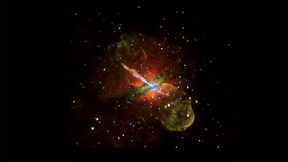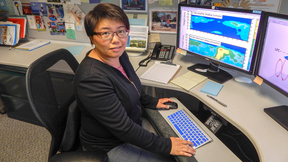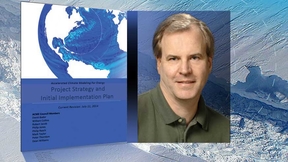Back
Physical and Life Sciences
Berni Alder: A pioneer of the times
Father of molecular dynamics to celebrate 90th birthday, 60th anniversary at the LaboratoryBerni Alder was born in Germany, but was a Swiss citizen. In 1932, his family moved to Zurich, just before Hitler came to power.In 1941, when he was 16 years old, he fled Switzerland right before the United States entered World War II and took a sealed train through occupied France…
New experimental research exposes the strength of beryllium at extreme conditions
Until recently, there were very little experimental data about the behavior of beryllium (Be) at very high pressures and strain rates, with existing material models predicting very different behaviors in these regimes. In a successful example of international research collaboration, a team of scientists from Lawrence Livermore National Laboratory (LLNL) and the Russian…
LLNL tops Physics of Plasma's most-cited list
Physics of Plasmas (PoP), a peer-reviewed journal publishing original experimental and theoretical contributions in plasma physics, recently released a list of the most-cited papers for January-June 2015.Out of the 30 most-cited papers on the list, the top five had lead authors from Lawrence Livermore National Laboratory. No. 8, 9 and 17 on the list were also led by LLNL,…
New experimental and theoretical research could help make more efficient windows
By tightly integrating experimental and theoretical techniques, a Lawrence Livermore National Laboratory team has provided fundamentally new insights into the specific factors that determine the absorption characteristics of copper complexes. The results demonstrate that conventional interpretations based on "ligand field theory" -- a staple concept in inorganic chemistry …
Project aims to use probiotic bacteria to protect algal crops and increase ecosystem resilience
A Lawrence Livermore team has received an additional $1 million to protect algal crops by developing "probiotic" bacteria to combat pond infestation and increase ecosystem function and resilience.Algal biomass can be converted to advanced biofuels that offer promising alternatives to petroleum-based diesel and jet fuels. Additionally, algae can be used to make a range of…
Stumbling into physics and sticking with it
While growing up in Puerto Rico, Miguel Morales was interested in basketball and volleyball and not much else.But that all changed when he picked up a science book."The idea of being an intellectual was not a popular thing," he said. "I stumbled into physics and all of a sudden there was nothing else for me. I sort of became obsessed with it and I spent all my time reading…
Icy comets serve as storks for life on Earth
Early Earth was an inhospitable place where the planet was often bombarded by comets and other large astrophysical bodies.Some of those comets contained complex prebiotic materials, such as amino acids and peptides (chains of amino acids), which are some of the most basic building blocks of life on Earth."The survivability of these compounds under impact conditions is…
First stars in the universe left a unique signature
Determining the chemical abundance pattern left by the earliest stars in the universe is no easy feat. A Lawrence Livermore National Laboratory (LLNL) scientist is helping to do just that.The first stars in the universe formed about 400 million years after the Big Bang (estimated at 13.8 billion years ago). Inside of these stellar furnaces, nuclear processes fused the…
Laboratory's role in underground explosives tests will help nation's detection capabilities
A Lawrence Livermore National Laboratory (LLNL) team played a leading role in fielding the recent Source Physics Experiment (SPE-4 Prime) detonated at the Nevada National Security Site (NNSS). The SPE tests, including the most recent one on May 21, consist of a series of seven underground, high-explosive field tests in hard rock that are designed to improve the United…
Lab researchers land geothermal energy award
Lawrence Livermore National Laboratory engineers Tom Edmunds and Pedro Sotorrio have been honored by the Geothermal Energy Association for their significant contributions during the past year to advancing technology, spurring economic development and protecting the environment.Edmunds and Sotorrio, of the computational engineering division at LLNL, received a special…
Fusion could be 'ZaPped' into reality
With funding from the Department of Energy, Lawrence Livermore National Laboratory (LLNL) and the University of Washington (UW) will work to advance the sheared-flow stabilized Z-pinch concept and assess its potential for scaling to fusion conditions.Fusion is the same energy that powers the sun and the stars, and scientists have worked for years to create the same power…
Unraveling the origins of lunar swirls
As the closest object in the night sky, Earth’s moon and its craters have long been studied. These craters, visible with the naked eye, have been formed over billions of years by impacts from both asteroids and comets.A new study recently published in the journal Icarus, led by Megan Bruck Syal of Lawrence Livermore National Laboratory, examines how cometary impacts may…
Lawrence Livermore scientists move one step closer to mimicking gamma-ray bursts
Using ever more energetic lasers, Lawrence Livermore researchers have produced a record high number of electron-positron pairs, opening exciting opportunities to study extreme astrophysical processes, such as black holes and gamma-ray bursts.By performing experiments using three laser systems — Titan at Lawrence Livermore, Omega-EP at the Laboratory for Laser Energetics …
Lawrence Livermore researchers use seismic signals to track above-ground explosions
Lawrence Livermore researchers have determined that a tunnel bomb explosion by Syrian rebels was less than 60 tons as claimed by sources.Using seismic stations in Turkey, Livermore scientists Michael Pasyanos and Sean Ford created a method to determine source characteristics of near-earth surface explosions. They found the above-ground tunnel bomb blast under the Wadi al…
Lawrence Livermore climate scientist earns Early Career Research award
Lawrence Livermore’s Yunyan Zhang, a climate scientist in the cloud process group within the Atmospheric, Earth and Energy Division, has earned $2.5 million for research to improve the understanding of how soil moisture and surface diversity affect cloud formation and precipitation. As the recipient of the Department of Energy Early Career Research Program (ECRP), Zhang…
NuSTAR provides explosive evidence for supernova asymmetry
New results from the NASA NuSTAR telescope show that a supernova close to our galaxy experienced a single-sided explosion.A team of scientists including Lawrence Livermore National Laboratory researchers found that X-ray emissions taken with the Nuclear Spectroscopic Telescope Array (NuSTAR) show that the Supernova 1987A explosion was highly asymmetric. The results appear…
Energy secretary honors LLNL climate scientist
Energy Secretary Ernest Moniz has awarded LLNL climate scientist David Bader with a DOE Secretarial Honor Award for his leadership of the Accelerated Climate Modeling for Energy (ACME) project.The Secretarial Honor Awards are the department's highest form of non-monetary employee recognition. Individual and team awardees are selected by the Secretary of Energy.William…
Implantable electrode coating good as gold
A team of researchers from Lawrence Livermore and UC Davis have found that covering an implantable neural electrode with nanoporous gold could eliminate the risk of scar tissue forming over the electrode’s surface.The team demonstrated that the nanostructure of nanoporous gold achieves close physical coupling of neurons by maintaining a high neuron-to-astrocyte surface…
Unlocking the secrets of star creation
On April 1, 1995, the Hubble Space Telescope, now celebrating its 25th anniversary, captured the famous images of the "Pillars of Creation" in the Eagle Nebula. Twenty years later to the day, the NIF Team conducted the first experiment in a new Discovery Science campaign aimed at finding clues to the mystery of how stars are born in these spectacular cosmic formations…
Lawrence Livermore instrument prompts researchers to rethink how Mercury formed
A versatile instrument developed by Lawrence Livermore National Laboratory (LLNL) scientists and riding on the first spacecraft to ever orbit Mercury is causing researchers to rethink their theories on the planet’s formation.Known as the Gamma-Ray Spectrometer, or GRS, the instrument is part of a suite of seven instruments onboard NASA’s Mercury MESSENGER (short for…

























